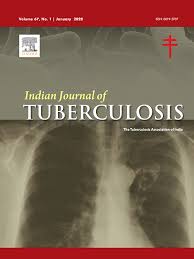Socio-demographic profile and outcome of TB patients registered at DTC Rewa of Central India

Citation: Rohit, R. T., Niranjan, A., & Pawan, P. A. (2018). Socio-demographic profile and outcome of TB patients registered at DTC Rewa of Central India. Indian Journal of Tuberculosis, 65(2), 140–144. https://doi.org/10.1016/j.ijtb.2016.11.015
Abstract: Background
Tuberculosis is a specific infectious disease caused by Mycobacterium tuberculosis. The disease is usually chronic with cardinal features such as persistent cough with or without expectoration, intermittent fever, and loss of appetite, weight loss, chest pain and hemoptysis.
Objective
(1) To assess the socio-demographic profile of the patients attending DOTS Center. (2) To assess outcome of treatment under DOTS Center.
Methodology
This is a Prospective Longitudinal study conducted among the patients attending DOTS center of DTC located at S.G.M.H. campus Rewa Madhya Pradesh Central India, during the last quarter of 2014, Study Duration: One year and two months i.e. starting from 1st September 2014 to 31st October 2015; total study sample size consisted of 137 patients who were newly registered during the last quarter of 2014 (from 1st October to 31st December 2014) at DOTS Center of DTC. After applying inclusion and exclusion criteria, a total of 133 newly registered patients were enrolled that can be considered as total sample size in the present study.
Result
Study population comprises a total of 133 patients; out of which 84 (63.15%) were male and 49 (36.84%) were female. In both most common age group are 21–30 year were 41 (30.82%) patients and least common was pediatric TB in age group <10 year were 10 (7.51%) patients, lower socio-economic class (class-V) 53.38% followed by class-IV or Lower middle class 29.32%, only 1.5% were from upper class. 96 (72.18%) patients were of category-I patient and 37 (27.81%) were category-II patient, 51 (38.34%) patients were cured, 70 (52.63%) had their treatment completed, so overall treatment success rate was 90.97%; in that, 2 cases were (1.50%) failure, 4 (3%) defaulters, 2 (1.50%) died during treatment and 4 (3%) were transferred out.
Conclusion
Study concluded that most of the patients belonged to lower socioeconomic status and in productive age group so it will increase the economic burden over the family; therefore, after increasing the living standard the outcome of disease becomes favorable.
Tuberculosis is a specific infectious disease caused by Mycobacterium tuberculosis. The disease is usually chronic with cardinal features such as persistent cough with or without expectoration, intermittent fever, and loss of appetite, weight loss, chest pain and hemoptysis.
Objective
(1) To assess the socio-demographic profile of the patients attending DOTS Center. (2) To assess outcome of treatment under DOTS Center.
Methodology
This is a Prospective Longitudinal study conducted among the patients attending DOTS center of DTC located at S.G.M.H. campus Rewa Madhya Pradesh Central India, during the last quarter of 2014, Study Duration: One year and two months i.e. starting from 1st September 2014 to 31st October 2015; total study sample size consisted of 137 patients who were newly registered during the last quarter of 2014 (from 1st October to 31st December 2014) at DOTS Center of DTC. After applying inclusion and exclusion criteria, a total of 133 newly registered patients were enrolled that can be considered as total sample size in the present study.
Result
Study population comprises a total of 133 patients; out of which 84 (63.15%) were male and 49 (36.84%) were female. In both most common age group are 21–30 year were 41 (30.82%) patients and least common was pediatric TB in age group <10 year were 10 (7.51%) patients, lower socio-economic class (class-V) 53.38% followed by class-IV or Lower middle class 29.32%, only 1.5% were from upper class. 96 (72.18%) patients were of category-I patient and 37 (27.81%) were category-II patient, 51 (38.34%) patients were cured, 70 (52.63%) had their treatment completed, so overall treatment success rate was 90.97%; in that, 2 cases were (1.50%) failure, 4 (3%) defaulters, 2 (1.50%) died during treatment and 4 (3%) were transferred out.
Conclusion
Study concluded that most of the patients belonged to lower socioeconomic status and in productive age group so it will increase the economic burden over the family; therefore, after increasing the living standard the outcome of disease becomes favorable.
Author(s): Indian Journal of Tuberculosis
Year: 2018
Language: English
Region(s): INDIA
Resource Type: Journal Articles
Source: Other
